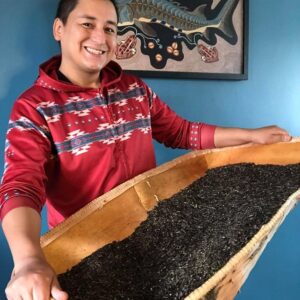Biigtigong Nishnaabeg artist reclaims language through art workshops

By Rick Garrick
THUNDER BAY — Biigtigong Nishnaabeg artist Joshua LeClair’s experience of being adopted into a Sámi family while studying at the University of Tromsø in Norway has encouraged him to use more Anishinaabemowin in his art workshops.
“My interaction with them and then their story of reclaiming their language just was really inspiring,” LeClair says. “It also gave me an aha moment to reclaim my language. My vision is that all of these workshops and when I communicate with others, I just speak Anishinaabemowin. That’s my dream, my long-term vision.”
LeClair says has done about 30-40 workshops for Anishinabek Employment and Training Services, Ontario Native Women’s Association, and schools in the Northern Superior Region.
“By the end of my workshops, I’m friends with these people,” LeClair says. “I really build a connection with the people who are in my workshops.”
LeClair says one workshop participant said they felt “like an empowered Anishinaabekwe” after the workshop.
“People always tell me I’m a great facilitator and I provide great information,” LeClair says. “I did political science and history [at university], my focus was on North America and Indigenous history, and there’s just so much awesome Anishinabe history that can be talked about and shared in these workshops that I do share.”
LeClair says he starts his workshops with ceremony, including smudging and hand drumming.
“Woodland Art is, yes, called Woodland Art, but sometimes it can be called Medicine Art because we’re making a circle and each one of us is a piece of that circle,” LeClair says. “This circle is only going to be as strong as each of us participate.”
LeClair, who has been painting, beading, and creating art for more than 25 years, says he enjoys teaching about Woodland Art and making birch bark baskets during his art workshops.
“Woodland Art (is) one of the main things I like sharing and teaching others about,” LeClair says. “I love harvesting birch bark, that’s a seasonal activity. We make baskets, little canoes. And then my beading, I’ve got two kinds of approaches I’m doing with that, Ojibwe florals and loom work.”
LeClair says he worked at Pukaskwa National Park for more than 10 years where he did workshops with school groups, tourists, and visitors.
“I shared programs, workshops, or anything about Anishinabek culture, identity, and history,” LeClair says. “So in doing my workshops for different organizations, institutions, schools, sometimes it’s for students, sometimes it’s for teams of staff, and sometimes it’s for clients of an organization.”
LeClair says he works with the organizations on their needs and what they want out of the workshop.
“Because art, I do think it is a form of therapy and I always try to highlight that when I come into these circles,” LeClair says, noting that he encourages participants to use a basic design to create their own art during his workshops. “I work with them to develop their own story and understanding of that.”
LeClair says his grandmother taught him how to sew and bead when he was young.
“That came around the same time they were trying to teach us beading as kids in [Biigtigong Nishnaabeg],” LeClair says. “So I’ve been beading for 25 years now.”
LeClair says he also began painting around the same time.
“I just always loved Norval Morrisseau and his bright vibrant colours,” LeClair says. “In our house growing up, we always had Gelineau Fisher paintings and his Woodland Art is immaculate. Woodland Art is all about storytelling, it comes from the pictographs and birch bark scrolls, and [for] Anishinabe, storytelling is who we are and what we are and how we tell stories.”


